Lazio and Roma derbies remain the be-all and end-all to fans of each club
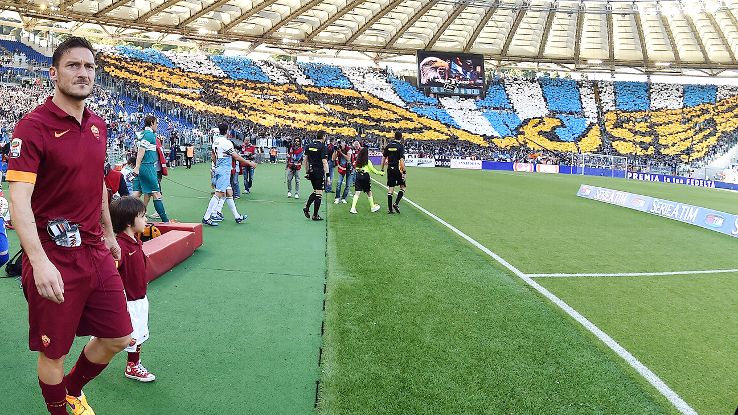
In the latest edition of ESPN FC's derbies series, which features eyewitness insights into some of the biggest rivalries in world football, Paolo Bandini goes to Italy to experience the Rome derby between Lazio and Roma.
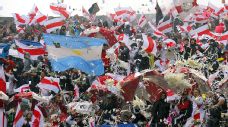
ESPN FC'S DERBY SERIES
- River Plate vs. Boca Juniors, by Sam Kelly
- Man City vs. Man United, by Iain Macintosh
- Celtic vs. Rangers, by Chris Jones
- Benfica vs. Sporting, by Lee Roden
- Everton vs. Liverpool, by Jeff Carlisle
- Olympiakos vs. Panathinaikos, by Michael Yokhin
- Borussia Dortmund vs. Schalke, by Uli Hesse
- Red Star vs. Partizan, by Andy Mitten
- Steaua vs. Dinamo, by Nick Ames
- Roma vs. Lazio, by Paolo Bandini
ROME -- The Stranger has been eyeballing me for a good minute from the end of the bar. At first I ignore him. But then I see him lean in toward the barman and gesture in my direction. He whispers, just loud enough that I can hear: "Is that guy a policeman?"
Under different circumstances, this might have been an unsettling moment. We are seated in a pub named Excalibur, one of Rome's most famous gathering spots for Lazio supporters, a few hours before the Derby della Capitale (Capital City Derby) between Lazio and Roma.
There is a history of violence around this fixture dating back several decades, and just yesterday the mayor of Rome, Ignazio Marino, used a newspaper interview to implore fans not to behave like "barbarians". It has been reported that as many as 1,700 police officers will be deployed to keep order. Some of those will be in plain clothes.
Clearly, I am not one of them. But I am aware that journalists are no more welcome than police in certain settings.
On this occasion, however, I can rest easy. The Stranger does not know me yet, but everybody else in here does. I visited Excalibur for the first time two nights ago, accompanied by a Lazio-supporting companion who has been drinking here for years.
The barman now explaining my presence is Roberto, one of three siblings who own the establishment. He opened Excalibur with his brother Gianluca and sister Giada in 1992. They were drawn to the idea of the neighbourhood pub they had seen during visits to Britain.
Excalibur did not even show football on TV until a year or two later. But the venue was popular from day one with Lazio supporters. Roberto and Gianluca were themselves Ultras, hardcore fans who attended almost every match. Their friends from the Curva Nord, the boisterous stand behind the Stadio Olimpico's northernmost goal, were among their first regular patrons.
Times have changed. Gianluca tells me he no longer identifies as an Ultra but only as a "tifoso" -- a regular fan. The endless reshuffling of football schedules to meet TV broadcasters' demands, allied to the dual responsibilities of running a business and becoming a father, mean he cannot get to every game. When he does go, Gianluca prefers to take his kids and watch from the Tribuna Tevere, a more sedate stand running down the east side of the pitch.
Gianluca is not going to the derby. He must stay back, run the pub and watch on TV. I ask him about what I can expect, and how likely I am to run into trouble along the way.
"It's diminished a great deal, the violence in Italy, and especially in Rome," he says. "The situations that do happen are mostly casual -- people who find themselves in the wrong place at the wrong time. It's not like it was many years ago, when you had strategies that were planned out before. Now almost everything happens by chance."
A few hours later, in another part of town, Roma supporters Massimo Ceci and Daniele Sellitri will be stabbed on their way to the game. Their assailants are alleged to have been Lazio fans. The attack took place close to the Piazza Mancini, an area just south of the river Tiber which thousands of Roma fans will pass through on their way to the Curva Sud.
The wrong places and times are not always as obvious as we imagine them to be.
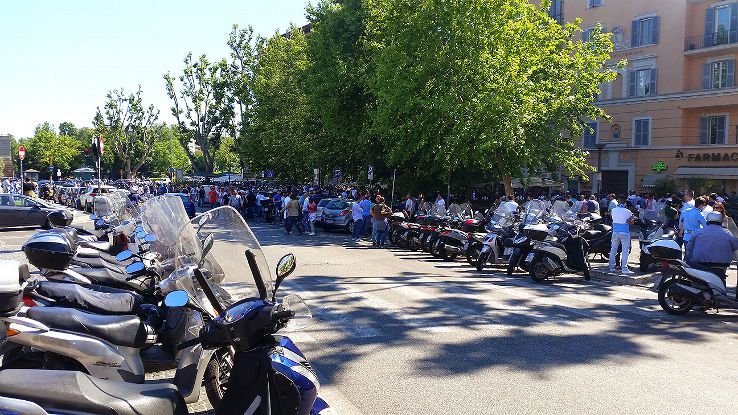
LAZIO'S ULTRAS GATHER mostly on the north side of the river. Two hours before kickoff, I depart Excalibur to join the congregation at Ponte Milvio, an ancient Roman bridge to the east of the Stadio Olimpico. The sun-bathed piazzale is packed with fans washing down fists full of suppli -- outrageously moreish deep-fried rice balls that conceal molten mozzarella and beef ragu at their core -- with glass bottles of beer.
One side of the square is bathed in blue smoke, gushing forth from a fan's flare. The air reeks of burnt gunpowder -- a phenomenon explained further when a paper bomb is lobbed out from the crowd. The name of such devices makes them sound innocuous. The reality of having one explode a few feet away from you is anything but. Only the half-chewed sandwich in my throat saves me from a childlike yelp of surprise.
Of all the many striking aspects of this scene, the most remarkable might be the fact it is unfolding at 4 p.m. on a Monday. The derby was originally supposed to take place a day earlier, on Sunday, May 24, but was moved back at one week's notice. This was the final act of a grand organizational shambles, caused by a clash between the Champions League and Coppa Italia finals. Lazio had been scheduled to face Juventus in the latter competition at the end of the season. Instead they wound up having to do so on the Wednesday before the derby. They lost in extra-time.
The derby was delayed by one day to accommodate this change, but city authorities in Rome have a standing rule that it cannot -- for policing reasons -- be played after dark. The compromise was a 6 p.m. kickoff on what, for most of the city, would be a regular working day.
None of which has kept fans from their usual pre-match rituals. This match is too important to approach any other way. Beyond city pride, tens of millions of Euros are at stake. Lazio need a draw to secure third place in Serie A, and with it a spot in next year's Champions League qualifiers. But a win would allow them to leapfrog Roma into second, which grants direct access to the lucrative group stage.
It is not the biggest derby this city has ever seen. On May 26, 2013, Roma and Lazio met in the Coppa Italia final, the first time they had ever played with major silverware on the line for both teams. Lazio won that day with a 71st-minute goal from Senad Lulic. Their supporters held an enormous mock funeral procession for the Giallorossi afterwards. Lulic gifted the boot with which the goal was scored to Roberto and Gianluca at Excalibur, who constructed a shrine next to the bar to display it.
Roma, though, have not lost a derby since. They appointed Rudi Garcia as manager in the summer of 2013, and he famously announced that he had "put the church back in the centre of the village" after leading his team to a 2-0 victory over Lazio that September. For a while, the Giallorossi seemed to be leaving their rivals behind, finishing second last season, then playing like title contenders for the first half of this campaign. Since January, however, the tables have turned, as Lazio have picked up nine more points than Roma. The likes of Antonio Candreva, Felipe Anderson and Marco Parolo are thriving under manager Stefano Pioli, while Garcia's team look flat. Francesco Totti has faded badly after an impressive start to the season. Roma's lack of goalscoring alternatives is glaring.
Around 90 minutes before kickoff, the procession to the stadium begins. Tightly wrapped flags are shouldered for the 10-minute walk down the Tiber. The diversity of unofficial team paraphernalia is impressive. A man walks by with a scarf with Paul Gascoigne's face on either end of it. Another with a baby blue one reading, simply, "Roma are s---".
Then there are the interlopers: fans of foreign clubs who have come along for the ride. As we leave Ponte Milvio I notice a gang of shaven-headed men sitting outside a bar wearing T-shirts that brand them as Wisla Sharks, supporters of the Polish club Wisla Krakow. I spy only a few, and think little more of it until later in the day, when close to 100 of them show up in the Curva Nord performing fascist salutes.
As we approach the stadium, we come across our first line of police, lined up in riot gear beside sky blue armoured wagons. They divert us north up the Viale Paolo Boselli, making sure we will not cross paths with Roma fans approaching from the far side of the ground.
Our path now will take us through the Stadio dei Marmi, a picturesque athletics stadium carved out of marble and surrounded by 59 marble statues of naked men in sporting poses. Both this, and the Stadio Olimpico exist side-by-side in what is effectively the backyard of the Italian Olympic Committee's headquarters.
I slip down the side of the stadium toward the area where I know the Roma fans are gathering. Another line of police in riot gear is waiting in the road, and yet I am able to stroll by unchallenged simply by sticking to the sidewalk that is separated from them by a hedge.
A journalist friend with a contact among the Roma Ultras had advised me not to visit this pre-game drinking post beside the Tiber. But when I get there the scene is peaceful enough. Much as with the Lazio fans at Ponte Milvio, they stand in groups, sing songs and set off fireworks. The mob of photographers hovering beside the police suggest more action was expected.
Entering the stadium is a saga. First, tickets and ID are checked at a gate that allows entry to a holding pen. A line of riot police wait just inside, alternately wielding shields, batons and what look like bean-bag guns. Stood between them are security staff who stop fans at random for frisk searches.
Next come the gates providing access to specific sections of the stadium. Ticket barcodes are held up to an electronic scanner, which unlocks an automatic turnstile. On the other side is a row of stewards checking tickets and ID again by hand. Both slower and fewer in number than the machines, these create an inevitable bottleneck. When I enter, 40 minutes before kickoff, this is an inconvenience, but I dread to think what the scene might look like at 5:59 p.m.
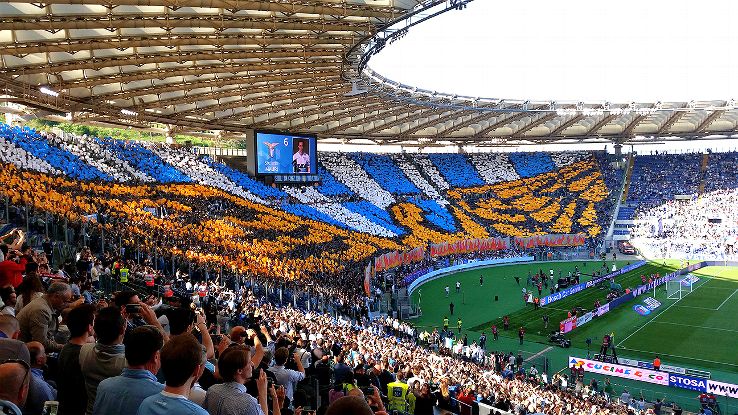
OLIMPIA THE EAGLE does not fly on derby days. Lazio's mascot does a lap of this stadium before most home games, but is not permitted to do so when her team faces Roma because of fears that rival supporters might target her with missiles. Instead, she perches on her handler's arm as he parades beneath the Curva Nord.
Above them, the Ultras are preparing their pre-game choreography. It begins with those at the bottom of the stand holding up cards painted in vivid red and yellow to create the effect of a wall of fire. Suddenly, the golden silhouette of an eagle appears above this, spanning the entire stand as it rises out from the flames.
Both the design and the execution are exhilarating.
Roma's Ultras offer no response, a small banner declaring their inaction as a protest against their club's American owner, James Pallotta. A section of the Curva Sud has been railing against him for weeks, after he refused to appeal a decision by the Italian sporting justice court to close their stand for one game as punishment for banners deriding Antonella Leardi, the mother of a Napoli supporter who was shot dead on his way to the venue before last season's Coppa Italia final.
No internal feud, however, could keep Roma's Ultras from baiting their rivals. One element of the derby lost to the TV audience is the back-and-forth that goes on between each end over the course of a game. Fresh banners are unfurled at regular intervals once play has begun, creating the effect of a conversation at a distance:
Curva Nord: "You are filth, inside and out."
Curva Sud: "Second place: for us a minimum requirement, for you a global triumph."
Curva Nord: "What day is it tomorrow?" (It will be the anniversary of Lazio's 2013 Coppa Italia final win.)
Curva Sud: "What memories of that shirt you wear... rigged games and the second division." (The Eagle motif on Lazio's shirt this season is a throwback to 1987, when they overcame a nine-point penalty to avoid relegation from Serie B.)
In both Curve, vast flags are held aloft. Flares are thrown constantly, one somehow clearing the running track and landing on the edge of the pitch. There are chants, too, but no instruments - a feature of this fixture in the past.
The Ultras I spoke to confirmed my suspicion that you do not see much of a match from the Curva. I mooted to one veteran Laziale that most English football fans would hate to have their view obstructed, even by a friend's flag.
"This is a difference of mentality," he replied. "If you ask someone here to lower their flag, they will tell you 'these are the colours of our team. Who the f--- are you to tell me not to show them off?'"
In truth, those with restricted views do not miss a great deal in the first 70 minutes of this derby. Miroslav Klose misses an early chance to put Lazio in front, but thereafter the game becomes cagey. Although neither team would ideally like a draw, both are a little too aware of the consequences of a defeat.
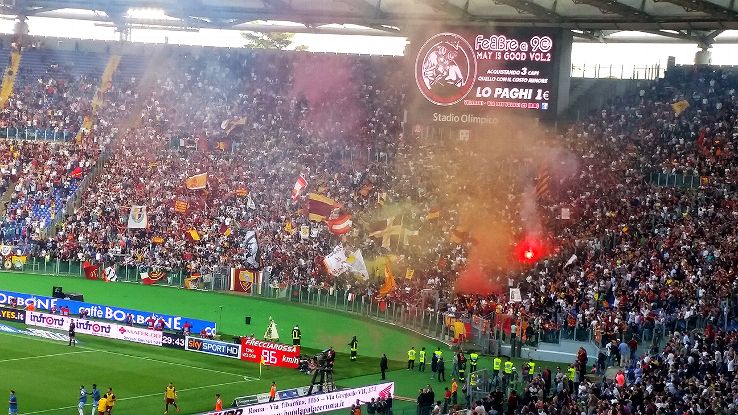
THE STADIUM WILL look deserted to television viewers. Roughly 50,000 tickets have been sold, and the two Curve are packed, but the Stadio Olimpico's main camera positions face out from Monte Mario stand toward the Tribuna Tevere, which is by some distance the emptiest section in the stadium.
Even knowing this fact, some observers might feel bemused. If this is such an important game in such a passionate footballing city, why had every seat not been filled?
There is no simple answer. Walking through the streets of Rome in the days leading up to the derby, there did come a point at which I wondered whether perceptions of football's importance here had been inflated too far by media hype.
The Roman edition of Corriere dello Sport was churning out derby-related content at a rate of more than 25 broadsheet pages per day, while the city's half-dozen sports radio stations talked of little else. And yet, it would also have been quite possible to walk through Rome without catching a hint of what was to come.
Two days before kickoff, I stopped by Testaccio, an area just south of the city centre renowned for strong Roma support. My intention had been to watch the Juventus-Napoli match among fans of the Giallorossi. It was a fixture with big implications for both Rome clubs. Napoli were fourth in the table and in position to draw level on points with Lazio, whom they would play on the final weekend.
I had imagined there would be hundreds packed in to watch at the Roma Club Testaccio, the local supporters' club. Instead, I found an old man named Sergio on his own in an empty room, fiddling with the sound system attached to a projector screen. He was, it turned out, the club president, and could not fathom my confusion at the lack of a crowd. "It's Saturday," he explained with a furrowed brow. "Roma don't play for another two days."
Sergio did reassure me that things would be different on Monday, showing me a lengthy list of members who planned to watch the derby at the club. He also gave me a hint of the local enthusiasm as he remembered Roma's 2001 Scudetto win.
"For six weeks you could only get around this neighbourhood on foot, because of the traffic," he said. "It was as though we won the Scudetto every day for a month and a half. OK, people would still go to work but at 5 o'clock the horns would start beeping, everybody would show up on scooters with their flags and scarves."
Times have changed. Roma's average attendances have fallen by more than a third in the 14 years since - from more than 64,000 per game to just over 40,000. But do smaller crowds necessarily mean a lesser passion? Lionello Manfredonia does not believe so. One of few players to have played for both Lazio and Roma, he recalls how a new Ultra group, the Gruppo Anti-Manfredonia, was formed after he joined the latter club in 1987, specifically to protest against his arrival.
"Ah yes, the famous 'GAM'," he says. "I was a bandiera [a banner player] for Lazio before, so even though I had been with Juventus for two years in-between, they didn't accept the idea that such a player could come to Roma. In the end, I had problems with both sets of fans."
If supporters no longer attend games as they once did, Manfredonia suspects it is not to do with a lack of interest but rather the grim state of Italian stadiums. "You're too far away from the match, it's not like it is in England," he says. "When you go to the cinema or the theatre, you want to be comfortable. In Italy, it's not a great service for the customer. People prefer to watch the match on TV."
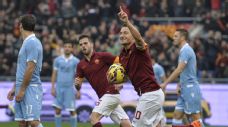
LAZIO vs. ROMA
- First meeting: Dec. 8, 1929 -- Roma won 1-0
- 176 games played (143 league, 18 cup, 15 unofficial)
- All-time wins: Lazio 48-65 Roma (63 draws)
- H2H, last 10 league games: Lazio 3-4 Roma (3 draws)
- Italian league titles: Lazio 2; Roma 3
His viewpoint is shared by James Pallotta, who has put a project to build a new stadium at the heart of his Roma project from day one. Even that, though, is only one part of the picture. Back at Excalibur, The Stranger -- having overcome his initial suspicions regarding my presence -- went on to tell me that, despite being a huge Lazio supporter, he no longer attended games. "Not since they introduced that f------ tessera del tifoso."
Few subjects unite opinion among Roma and Lazio Ultras -- and indeed, those of every other team in Italy -- quite like the tessera, a supporter ID scheme operated by football clubs in conjunction with law enforcement. Signing up is mandatory for anyone who wants to purchase tickets for the home supporters' section of a given stadium.
The only ways to get in without a tessera are either to sit in the more expensive neutral stands, or to get a friend who owns a tessera to buy your ticket for you, effectively vouching for your behaviour. In either case, your name must still be provided, and another form of identification furnished at the entry gate.
Proponents of the tessera argue that it makes it easier for clubs to keep troublemakers out. Fans with stadium banning orders are unable to sign up. But opponents contend that the tessera criminalises the innocent, subjecting all football spectators to Orwellian levels of surveillance. Ultras, in particular, feel persecuted, since they are the ones who traditionally pack out the relevant parts of the stadium.
One Ultra even suggested to me that the tessera had been intentionally devised to discourage people from going to the games. "Less people in the stadium means more people staying at home and paying for a Sky TV subscription," he said.
The logic appears flawed. Empty stadiums look less appealing to TV audiences and, crucially, also to international broadcasters. But such scepticism is far from unique. The expectation that people in positions of authority will always conceal their true motives is so widespread in Italy that there is even a word for it -- "dietrologia", or "behind-ism". In both politics and football, conspiracy theorists have often been proven correct.
Of course, the Ultras themselves stand accused of making the stadium a less welcoming place for the average fan. Here, too, it is hard to pick apart fact from fiction. Sensationalist media coverage has often portrayed Ultras with a broad brush as troublemakers and hooligans. Despite having butted heads with them recently, Pallotta rejects this impression.
"I think there's a few people that hurt the reputation of the 99 percent who are just unbelievably passionate fans," he tells me by phone from New York. "On a game-by-game basis there's very few incidents. It's not like there's every game there's something going on.
"And, by the way, there's a lot of stuff that goes on in the U.S. outside of stadiums, too. I can remember growing up, sitting in the bleachers of the Boston Red Sox games, and when the New York Yankees were in town, by the third inning, 25 percent of the bleachers would be cleared out, because the cops were taking people out."
Equally, though, we cannot ignore the extremists. The Rome derby has witnessed not only violence but racism and anti-Semitism in the stands.
The most infamous meeting between Roma and Lazio took place in March 2004. Fans had fought before kickoff outside the stadium, and early in the second half a rumour circulated that a young boy had been knocked down and killed by a police car during the melee. Ultras supporting both clubs reacted by assaulting police inside the stadium.
Three men from the Curva Sud ran onto the pitch and asked Roma's captain, Francesco Totti, to end the match. Chaos reigned as players and coaches consulted while the stadium's public address repeatedly (and accurately) stated that no child had been killed. The decision to abandon the game was eventually taken by the then league president Adriano Galliani, who was hundreds of miles away at the time.
The nature of the day's events are still contested. Ultra groups were accused of orchestrating the whole scene as a show of strength, but they claimed only to have been reacting to what they understood as extraordinary circumstances. Very often the violent clashes around the game have generated debate along these lines. Harder to explain away have been pre-prepared gestures, such as vast anti-Semitic banners that stretched across an entire stand. A long-running back-and-forth between the two sets of Ultras culminated when Lazio fans unfurled a 50-metre sign toward Roma fans that read: "Auschwitz is your homeland, the ovens are your houses".

ROMA AND LAZIO both owe their present existence, in some degree, to right-wing politics. Italian football in the first part of the 20th century had been dominated by clubs from the north of the country. In 1927, officials from Benito Mussolini's ruling fascist party decided it was unacceptable for the capital city to lag so far behind. A merger was orchestrated between three of Rome's biggest clubs - Alba Roma, Fortitudo and Roman. Together they formed AS Roma.
Lazio, too, were supposed to have been part of this arrangement. That they remained independent is thought to have had a great deal to do with Giorgio Vaccaro, an army general, Fascist Party member and supporter of the Biancocelesti who intervened directly in negotiations.
By combining three clubs' fanbases, Roma instantly became the best-supported team in the city. Lazio, to this day, take pride in remaining the oldest. They had been born as a running club in 1900, but expanded to include football a year or so later.
To begin with, Lazio were considered the rich man's team - their support drawn primarily from wealthy, right-wing enclaves in the north of the city. Roma's core fan base was working class and, despite the Fascist Party's involvement in their club's creation, tended to lean to the left.
Over time, these distinctions have faded. Politics in Rome has shifted to the right, and this is reflected in both Curve. On matchday, it is easy to find Ultras from both sides wearing tattoos of fascist symbols.
Equally, though, it is true that a great many people in both the Lazio and Roma Curve do not care about politics. When I ask Massimiliano Maidano, a social anthropologist and political expert who studies focus on the link between football, politics and society, to define what exactly the word "Ultra" denotes, he replies that it is simply "someone that puts the team at the centre of their attention".
"To be an Ultra is to give 100 percent of yourself, sing 90 minutes in the Curva without stopping," he adds. "To be an Ultra does not mean watching the game. You go to the stadium to support the team, because that is better than watching the game ... Then, for some people it goes over -- so it's not just about supporting, it's also about confronting and defending the honour of your team."
In their book "Football, Fascism and Fandom," Alberto Testa and Gary Armstrong make a distinction between those Ultras who did put politics at the centre of their identity and those who did not. Speaking to Testa, a researcher in deviance and crime at the Ealing Law school -- University of West London, before the game, I asked which group was greater in number. "The last estimate was in 2013," he said, but those whose agenda is political "were only 11 percent of the total nationally."
He believes, though, that this number is increasing. "The extreme right is growing in all parts of Europe," says Testa, "and all over Europe, the extreme right is monopolizing the terraces. You cannot speak about Ultras without underlining that there is a strong ideological component."

BACK AT THE Stadio Olimpico, Roma take the lead out of nowhere in the 73rd minute. Juan Iturbe, the €22 million winger whose shabby first season at the club had previously yielded a single goal, pokes the ball in from close range. He disappears under swarm of his teammates, and the Curva Sud disappears under a sea of red and gold smoke.
Lazio equalise with nine minutes remaining. Filip Djordjevic, who had seen a shot come back off both posts during the Coppa Italia final defeat to Juventus four days earlier, nods the ball home after it is headed across goal by Miroslav Klose. The north part of the stadium reacts with every bit as much glee as the south had moments earlier.
The final twist is yet to come. Four minutes later, centre-back Mapou Yanga-Mbiwa restores Roma's lead, glancing a header into the corner from a free-kick. Signed from Newcastle in the summer of 2014, it is the first goal he has scored in a professional game for more than three years.
While the majority of Lazio fans around me have been stunned to silence, a Roma-supporting 15-year-old several rows in front has leapt to his feet and is gesturing with furious delight toward the Curva Nord. His father tugs nervously at the back of his shirt while glancing apologetically over his shoulder.
Next to me, a boy no older than 13 lights up what is, by my count, his eighth cigarette of the game. "For f---'s sake," he mutters, with a world-weariness befitting of a man many times his age.
The final whistle puts him out of his misery. Roma have won, 2-1.

LEAVING THE STADIUM, I follow the stream of Roma supporters sweeping back toward the centre of town. Many stop at the first beer-selling establishment they come across, a standalone kiosk called Due Rive that sits in a small park across the Ponte Duca d'Aosta - close to where Massimo Ceci and Daniele Sellitri were stabbed earlier in the day. Songs are sung, and furiously competitive games of table football played just outside.
But I want to see how the result has been received elsewhere in the city. I jump onto the first bus I see. For the first few streets, scooters with celebrating Roma supporters pass by us on either side - horns honking and scarves fluttering from the wrists of passengers riding pillion.
I will later learn that clashes between supporters and police were taking place outside the ground at around this time. Pictures from the scene show young men throwing flares and bottles with their faces covered. Wisla Sharks are present in the background of some of them.
Oblivious, for now, I decide to keep moving south, to see if Testaccio is celebrating with even a fraction of the enthusiasm that it did that league title 14 years ago. No such luck. Barely two hours after the game has ended, I find the Roma Club Testaccio closed with its shutters down.
On the one hand, I suppose this is reasonable. It is, after all, 10 p.m. on a Monday night. On the other, I can hear the sound of music playing a few streets over.
I follow the noise into a square, where I find a pair of cheesy middle-aged crooners - one man and one woman - delivering comedic ditties in thick Roman dialect. They have a keyboard, matching outfits, and a sound system entirely too loud for entertaining 17 locals in a residential neighbourhood. But their audience hoots with delight as they rip through a chorus of "You Don't Make Love with a Keyboard".
If anybody here is aware that a football match happened today, they seem to have moved on. Surprised, and a little disappointed, I conclude that it is probably time for me to do the same.
Winding my way through empty streets a few blocks away, I catch the tinny sound of people shouting over one another. Glancing upward, I see an open apartment window, and within it the silhouette of a man backlit by green hues. He is watching studio analysis of the T-shirt Francesco Totti wore after the game.
Perhaps Rome's passion for its derby is not diminished. You just have to look a little harder to find it.
Paolo Bandini is a European football writer and broadcaster. Follow him on Twitter @Paolo_Bandini.
Comments
Use a Facebook account to add a comment, subject to Facebook's Terms of Service and Privacy Policy. Your Facebook name, photo & other personal information you make public on Facebook will appear with your comment, and may be used on ESPN's media platforms. Learn more.



















